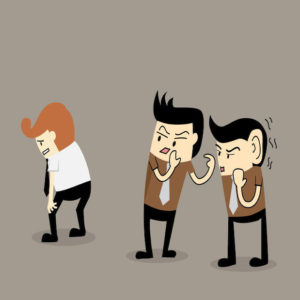By Dr. Ken Broda Bahm:

There is often something distinctive about the person bringing a case. Whether they are the victim in a discrimination or harassment case, a whistle-blower in an employment case, or a number of other case types, their act of coming forward has marked the individual as outside the social circle of a corporation or group. Whether that exclusion is the cause of the claim (for example, ostracism is an increasingly common form of harassment) or an effect of the claim, that separation is going to be part of the identity of that party or witness. And this outsider status will influence how that person is viewed by jurors. Are they a maverick or a malcontent, or something in between? The answer will add or detract from their credibility.
An interesting new study suggests that the way they are viewed will, in some surprising ways, depend on their similarity to the group that has excluded them. A team of researchers from the University of Basel (Rudert, Sutter, Corrodi & Greifeneder, 2018) published the article in the current issue of the Journal of Personality and Social Psychology. When presented with a number of different scenarios, research participants viewed social exclusion as worse when the person is visibly different from the rest of the group — different not just in the factors that you think might matter in litigation (e.g., race, gender, or age) but different even on superficial factors like hairstyle. When the excluded individual is similar to the rest of the group, the research participants seem to reason that the excluded individual must have brought it on themselves somehow. In this post, I’ll share a few thoughts on how this can influence the credibility of the ‘odd man out’ in litigation.
Similarity and Separation
For persuaders, the strategy of identification is a common one. Some would even say that it is the master strategy: A persuader succeeds by building or drawing attention to common ground. That can mean similarities of situation (We all live here), similarities of assent (We all agree that…) or similarities of formal style or language. We also tend to adapt new views when we are shown that these views bear a similarity to views we already hold. For that reason, advocates and persuaders are often focused on emphasizing the similarities between themselves and their positions on the one hand, and their audience and that audience’s prior beliefs on the other hand.
That, at least, is how the idea of similarity typically works, and trial lawyers will try to build as much similarity as possible for themselves, their clients, and their witnesses. The factor of social exclusion, however, seems to change that dynamic. In that case, a focus on similarities between the complainant or whistle-blower and the group at large can rebound back upon that individual, causing an audience to implicitly reason, “If you’re so similar to the others, and you were still excluded from the group, then it must have been something you did.” In contrast, salient dissimilarities invite the belief that exclusion was a result of differences, and that is unfair.
When to Build Similarity
This research suggests that one strategy in answering the claims of someone who is claiming to be a victim of the group is to argue the they are really a member of the group by building on similarities including common experience, knowledge, and language. If someone who is claiming to be a victim of harassment, for example, also participated and laughed at some of the same jokes as the rest of the group, that can psychologically undercut their claim. If they share a great deal of common ground with those they’re now accusing, jurors may see inconsistency and wonder why they are singling themselves out.
When to Build Difference
If you are representing this discrimination or harassment victim or whistle-blower, on the other hand, then you want to highlight differences. And what the research points out is that it is not just the differences you would think of: the factors that make them part of a cognizable group based on gender, age, race, religion, etcetera. Instead, focusing on any difference seems to work. As long as you aren’t creating an alternate cause for the disparate treatment, it helps to be able to show that, in other ways, this person was really not a member of the group. That focus will help jurors reach the conclusion that the social exclusion was caused by the group and not by the individual.
Other Posts on Employment and Whistle-blower cases:
- Address the Silence of a Delayed Harassment Claim
- Understand the Whistleblower
- Embrace the Whistleblower
Rudert, S. C., Sutter, D., Corrodi, V. C., & Greifeneder, R. (2018). Who’s to blame? Dissimilarity as a cue in moral judgments of observed ostracism episodes. Journal of personality and social psychology, 115(1), 31. DOI: 10.1037/pspa0000122